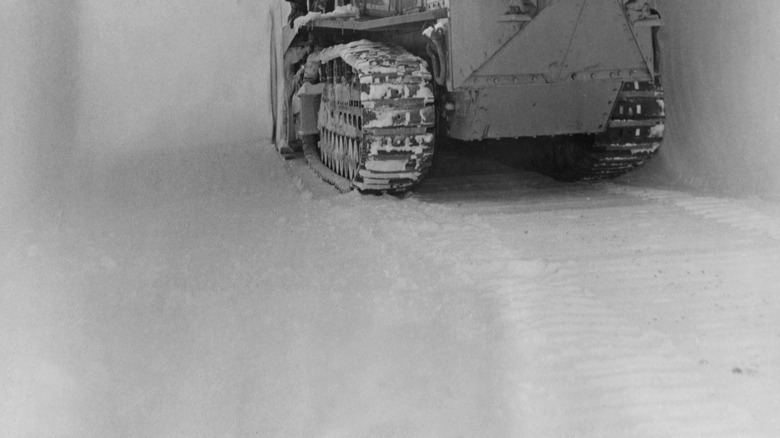NASA Found A Secret 100-Foot Deep Military Base In Greenland - Here's What It Was Used For
When one thinks of the National Aeronautics and Space Administration, a few things likely come to mind. Space expeditions, Moon landings, and Mars rovers are sure to come up first, as the organization has put a lot of emphasis on the "Space" part of its name throughout the years. However, there's more to NASA than exploring the cosmos, with its advanced technology often being utilized to make major discoveries on planet Earth. A prime example of this is NASA's recent discovery of a hidden decades-old military installation located 100 feet beneath the Greenland Ice Sheet.
This discovery was made by NASA scientist Chad Greene, who took radar images of the ice only to find the over half-century-old base buried underneath. As it turns out, this was a base constructed between June 1959 and October 1960 by the United States Army Corps of Engineers, which came to be known as Camp Century. It was a joint effort by the U.S. and Greenland and came about as a result of the Defense of Greenland Agreement of 1951. This allowed the U.S. and other North Atlantic Treaty Organization members to use the base to defend Greenland and the surrounding NATO countries. It was also intended for Project Iceworm, which would've seen ballistic missile launch stations built and hidden under the ice. The U.S. has plenty of military bases around the world, though most are active and above ground. Therefore, one has to ask, why was the subterranean Camp Century seemingly left behind?
What led to the abandonment of Camp Century?
From the very beginning, Camp Century proved a nightmare for those involved. Given the fragile nature of the ice shelf, the construction of this massive "City Under the Ice" was extremely tedious. Costing around $8 million to construct, the base required approximately 6,000 tons of supplies that all had to be moved via bobsled — traveling at roughly 2 mph — from Thule Air Base, now known as Pituffik Space Base. Of course, this couldn't be done until a 1,000-foot passage dubbed Main Street was dug through the snow and ice by soldiers, so it goes without saying that those involved in Camp Century's construction had their work cut out for them.
Unfortunately, their work wasn't worth it for long. The site was only in operation for eight years, ultimately shutting down in 1967. While the concept behind Camp Century made some sense, the fact is that the location was far from ideal for consistent military operations. The Greenland ice sheet lacked the stability to sustain the base and all of the personnel within it, with regular structural failures and subsequent repairs proving quite a costly nuisance. At the time of publication, the base remains unenterable due to its collapse over the years, though it's entirely possible that as Greenland's ice sheets melt away, it could be seen and reached once again.
Seeing as it never amounted to much, Camp Century will endure as a historical oddity. NASA's rediscovery of it serves to remind the world that sometimes U.S. military operations aren't all that well thought-out, and that, obviously, building a compound into sheets of ice isn't a very structurally sound idea.

